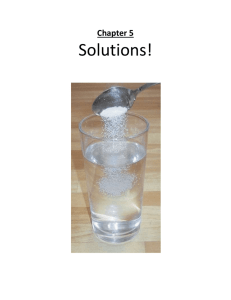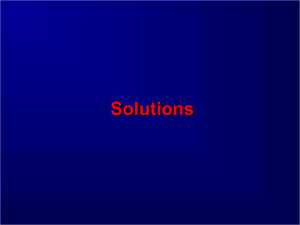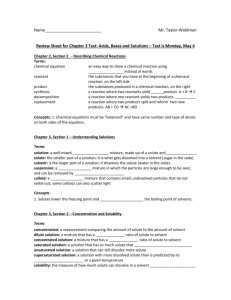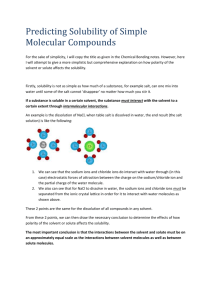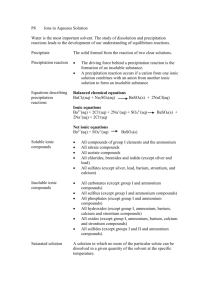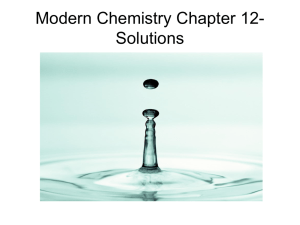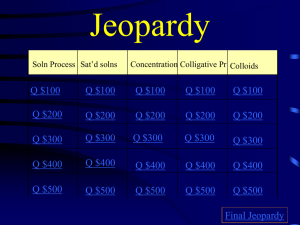Solute
advertisement
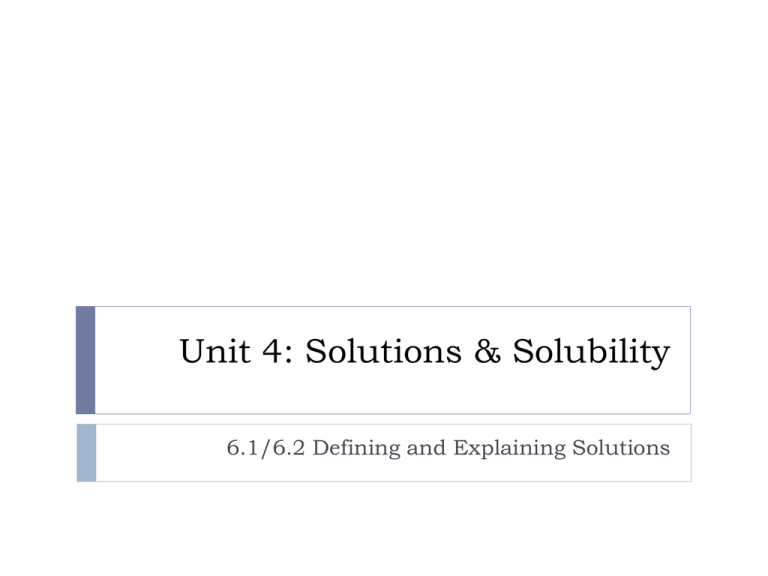
Unit 4: Solutions & Solubility 6.1/6.2 Defining and Explaining Solutions Solutions: a definition a type of mixture mixtures can be separated by non-chemical means such as filtration, heating, or centrifugation a homogeneous mixture the mixture is the same all the way through does not settle out if left to sit, whereas most heterogeneous mixtures do Homogenous vs. Heterogeneous The Parts of a Solution Solute = a substance that is dissolved in a solvent (e.g. salt, NaCl, in saltwater) Solvent = the medium in which a solute is dissolved; often the liquid component of a solution (e.g. water, in saltwater) in a solution, there is more solvent than solute Solutions Classifying Solutions Types of Solutions: Electrical Conductivity The state of their solute and solvent Electrolyte Nonelectrolyte gas solute in gas solvent (eg. air) Solid solute in liquid solvent (eg. saltwater) pH (Acid, Base or Neither) Acidic Basic Neutral Conductivity Electrolyte = a compound that, in an aqueous solution (water is the solvent), conducts electricity Mostly ionic compounds Nonelectrolyte = a compound that, in an aqueous solution, does not conduct electricity Mostly molecular compounds pH Acid = a substance that, in aqueous solution, turns litmus paper red (pH is less than 7) Base = a substance that in an aqueous solution, turns litmus paper blue (pH is greater than 7) Neutral = a substance that, in aqueous solution, has no effect on either red or blue litmus paper; neither acidic nor basic (pH = 7) Unit 4: Solutions & Solubility 6.2 Explaining Solutions Explaining Solutions Why do only some chemicals dissolve in water? Why are some chemicals mutually attracted to one another? Recall: Intermolecular Forces = an attraction between molecules Polarity and Solubility Polar substances dissolve in polar solvents Polar solute molecules are surrounded and suspended in solution by polar solvent molecules (see handout) Non-polar substances dissolve in non-polar solvents In other words: like-polarity substances dissolve in each other (“like dissolves like”) Explaining Non-aqueous Mixtures London Dispersion forces are weak intermolecular forces responsible for nonpolar substances dissolving in non-polar solvents Recall: Hydrogen Bonding a relatively strong dipole-dipole force between a solute with N, O, or F lone pairs or with a H-N, H-O, or H-F bond and water when multiple hydrogen bonds between solute and solvent is possible, we would expect an especially high solubility (see handout) Hydrogen Bonds between water molecules Ionic Compounds in Water More ionic compounds dissolve in water than in any other known solvent… Ionic compounds dissociate into individual aqueous ions (see handout) Dissociation = the separation of ions that occurs when an ionic compound dissolves in water (see handout) Ionic Compounds in Water Ionic Compounds in Water Predicting Solubility: Group Activity Rank the molecular compounds from greatest to least solubility in water and explain your prediction. Hint: examine the Lewis structures carefully and consider the type of intermolecular bond (LF, D-D or H-B) that it forms with water. Also, consider the possibility of multiple hydrogen bonds. Homework: Read pg. 268 - 279 Do #3, 5 on pg. 277 Do #7, 9 – 11 on pg. 279

